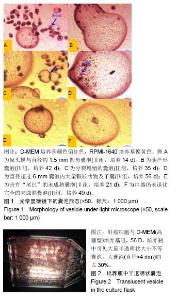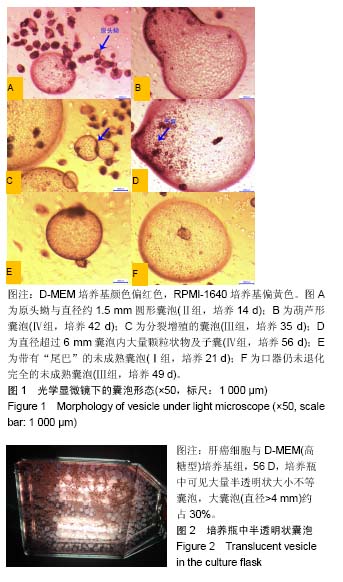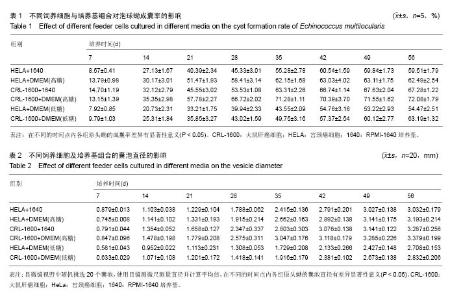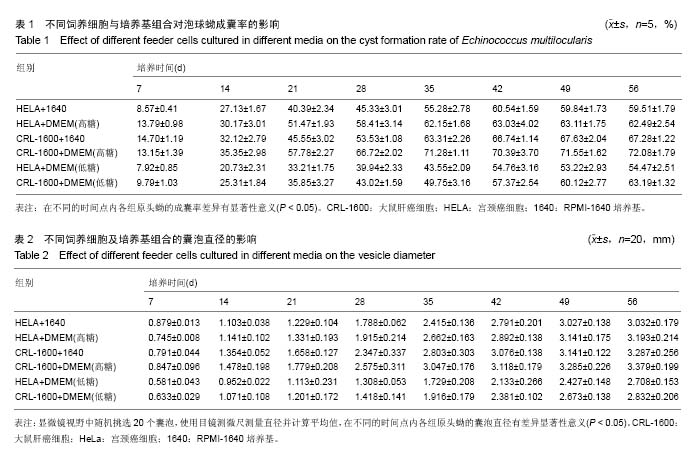| [1] Brunetti E, Kern P, Vuitton DA. Expert consensus for the diagnosis and treatment of cystic and alveolar echinococcosis in humans. Acta Trop. 2010;114(1):1-16. [2] 刘平,李金花,李印,等.包虫病病原在我国的流行现状及成因分析[J].中国动物检疫,2016,33(1):48-51.[3] Dieckmannschuppert A, Ruppel A, Burger R, et al. Echinococcus multilocularis: in vitro secretion of antigen by hybridomas from metacestode germinal cells and murine tumor cells. Exp Parasitol. 1989;68(2):186-191.[4] Toledo A, Cruz C, Fragoso G, et al. In vitro culture of taenia crassiceps larval cells and cyst regeneration after injection into mice. J Parasitol. 1997;83(2):189-193.[5] Galindo M, Paredes R, Marchant C, et al. Regionalization of DNA and protein synthesis in developing stages of the parasitic platyhelminth Echinococcus granulosus. J Cell Biochem. 2010;90(2):294-303.[6] Koziol U, Rauschendorfer T, Rodríguez LZ, et al. The unique stem cell system of the immortal larva of the human parasite Echinococcus multilocularis. Evodevo. 2014;5(1):10.[7] Spiliotis M, Lechner S, Tappe D, et al. Transient transfection of Echinococcus multilocularis primary cells and complete in vitro regeneration of metacestode vesicles. Int J Parasitol. 2008;38(8-9): 1025-1039. [8] Hemphill A, Gottstein B. Immunology and morphology studies on the proliferation of in vitro cultivated echinococcus multilocularis metacestodes. Parasitol Res. 1995;81(7):605-614. [9] 赵阶峰,夏海洋,郁晓峰,等.不同培养基及不同温度对体外培养泡球蚴原头节的影响[J].中国人兽共患病学报,2015,31(3):244-246. [10] 米晓云,古努尔•吐尔逊,张壮志,等.多房棘球绦虫-泡球蚴的体外培养研究[J].中国动物传染病学报,2011,19(4):67-70.[11] Brehm K, Koziol U. Echinococcus-host interactions at cellular and molecular levels. Adv Parasitol. 2017;95:147-212.[12] 王季武.泡球蚴体外厌氧培养模型建立及影响体外培养泡球蚴生长发育因素研究[D].厦门:厦门大学,2011. [13] 张传山,李朝旺,范金亮,等.多房棘球绦虫原头蚴对体外培养宿主肝细胞MAPK信号通路影响的初步研究[J].中国病原生物学杂志,2011,6(8):574-577.[14] Brehm K, Wolf M, Beland H, et al. Analysis of differential gene expression in Echinococcus multilocularis larval stages by means of spliced leader differential display. Int J Parasitol. 2003;33(11):1145-1159.[15] 张怀,张示杰,陈骞,等.缺氧对肝泡状棘球蚴原头节血管内皮生长因子和CD34表达的影响研究[J].中国全科医学,2017,20(14):1702-1706.[16] 曾红春,王俊华,刘文亚,等.早期大鼠肝泡状棘球蚴病模型的超声表现与病理对照[J].中国介入影像与治疗学,2015,12(8):508-511.[17] 李玉鹏,吐尔洪江•吐逊,沙地克•阿帕尔,等.多房棘球蚴感染BALB/c小鼠转录因子T-bet、GATA-3 mRNA表达的实验研究[J].中国病原生物学杂志,2016,11(6):530-534.[18] 李红军,张艳琼.肿瘤细胞培养中的问题及采取措施[J].教育教学论坛, 2013,(13):131-132.[19] 唐岩,唐军民.肿瘤细胞培养、冻存及复苏过程中的工作体会[J].解剖学杂志,2009,32(4):561-562.[20] 郝广萍.人肝癌细胞HepG2培养方法探究与分析[J].华北理工大学学报(医学版),2018,20(1):7-10.[21] 周启锋,任利,张灵强,等.肝泡状棘球蚴病动物模型的研究进展[J].临床肝胆病杂志,2017,33(11):208-211.[22] 武坚坚.多房棘球绦虫Sox2基因的克隆与功能鉴定[D].厦门:厦门大学, 2014.[23] 商桂华.多房棘球绦虫OCT4基因的克隆及功能鉴定[D].厦门:厦门大学, 2014.[24] 袁丽英,张壮志,石保新,等.细粒棘球蚴-原头蚴体外培养成囊模型的建立[J].畜牧与兽医,2009,41(7):29-31. [25] 马海龙,李兆勇,孙世安,等.肝癌细胞及其上清液体外培养多房棘球蚴的实验研究[J].武警后勤学院学报(医学版),2012,21(11):864-867. [26] 马海龙.泡球蚴体外培养模型的建立及细胞亲和性观察[D].乌鲁木齐:新疆医科大学,2008. [27] Spiliotis M, Tappe D, Sesterhenn L, et al. Long-term in vitro cultivation of Echinococcus multilocularis metacestodes under axenic conditions. Parasitol Res. 2004;92(5):430-432.[28] Spiliotis M, Brehm K. Axenic in vitro cultivation of Echinococcus multilocularis metacestode vesicles and the generation of primary cell cultures. Methods Mol Biol. 2009;470(1):245-262. [29] 赵翔,张沙,肖军军,等.RPMI-1640和D-MEM培养基中肝癌细胞系BEL- 7402与HepG-2的生长状态比较[J].中国组织工程研究, 2011,15(11): 2002-2005.[30] 张迪,夏薇,芦瑶.RPMI-1640培养基和DMEM培养基中HepG-2细胞生长状况[J].现代养生,2017,12(24):35-36. |



